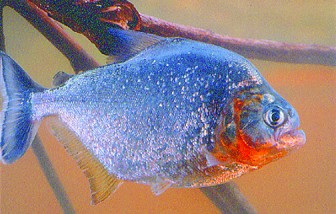Piranhas belong to the family Characidae and are related to herbivorous species like the Pacu. Piranha can be found in the Amazon and Orinoco river basins, the Guianas and Paraguay-Paraná and São Francisco river systems. Locally they are called Perai. The most famous of the perai are the red-bellied perai (Pygocentrusnatterei) and the black perai (Serrasalmusrhombeus).
Worldwide perai are known for their sharp teeth and voracious appetites. Scientists are still debating which species should be officially included in the Piranha group. While the actual number is unknown it is estimated that there are some 30-60 species in the group. Traditionally, true Piranhas were limited to the genera Pristobrycon, Pygocentrus, Pygopristris and Serrasalmus due to their teeth specialisation.

All species of piranha have a single row of sharp teeth in both jaws. The triangle-shaped teeth are tightly packed and interlocking. The teeth are used for puncturing and shearing their meal.
Piranhas are omnivorous and research has shown that only a small group eat meat as part of their diet. Some species are known to be completely herbivorous! For those species that feed on meat they are known to hunt in various ways. The red-bellied perai has been observed in an ambush mode, lying in wait for their prey; they are also known to actively pursue a prey, catching and eating it. Researchers believe the reputation that piranhas have for attacking is false. It is believed that the fish will attack when it senses an injured or stricken prey.
Only a few species move in shoals (large groups) and so when a large number of perai are observed in a location it is believed they were attracted by the feeding frenzy.
Piranhas are important ecological components in their habitats. They are largely restricted to the lowland river drainages but are widespread, being found in a wide variety of habitats. They are abundant in their local habitats and multiple species can be found together. They act both as predators and scavengers. Their presence is known to influence the distribution and species make-up of local fish communities. Economically the species are caught for the aquarium fish trade where the different species can be expensive to acquire.
Rain forests are rich in biodiversity and are home to many different plants and animals. In addition, indigenous communities make their homes there. Even if you don’t live in the rain forest, humans rely on the forest for resources such as building materials (wood and lianas), medicine and fruits. Rain forests also provide essential environmental services for life on earth; they create soil as well as prevent soil erosion, produce oxygen though photosynthesis, maintain clean water systems, and are a key defence against climate change.
The Iwokrama Rain Forest is 371,000 hectares, located in the heart of Guyana. Our mission is to develop strategies for conservation and sustainable development for local people in Guyana and the world at large. We are involved in tourism, training, research and our timber is certified by the Forest Stewardship Council. Come and visit us in the rain forest or at http://www.iwokrama.org.




